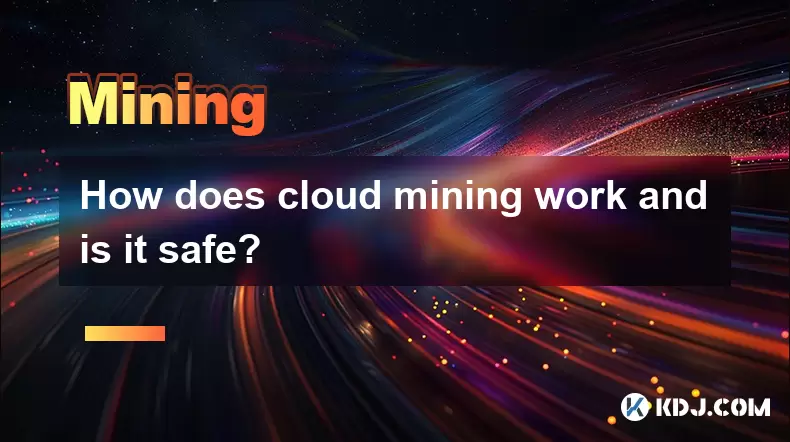-
 bitcoin
bitcoin $121833.232455 USD
-0.63% -
 ethereum
ethereum $4394.437030 USD
-2.00% -
 tether
tether $1.000570 USD
0.04% -
 bnb
bnb $1255.553465 USD
-3.73% -
 xrp
xrp $2.814944 USD
-1.59% -
 solana
solana $221.835346 USD
-2.40% -
 usd-coin
usd-coin $0.999869 USD
0.01% -
 dogecoin
dogecoin $0.249495 USD
-1.32% -
 tron
tron $0.336905 USD
-1.24% -
 cardano
cardano $0.816464 USD
-1.69% -
 chainlink
chainlink $22.130946 USD
-1.27% -
 hyperliquid
hyperliquid $44.208522 USD
-3.46% -
 ethena-usde
ethena-usde $1.000521 USD
0.02% -
 sui
sui $3.422897 USD
-2.51% -
 stellar
stellar $0.380164 USD
-1.31%
How does cloud mining work and is it safe?
Cloud mining lets users mine cryptocurrencies like Bitcoin by renting remote hashing power, avoiding the need for expensive hardware or technical expertise.
Jul 18, 2025 at 01:00 am

What Is Cloud Mining?
Cloud mining refers to the process of mining cryptocurrencies such as Bitcoin, Ethereum, or Litecoin through remote data centers that offer shared processing power. Instead of purchasing and maintaining expensive hardware like ASIC miners or GPUs, users can rent computing power from cloud mining providers.
This service allows individuals to participate in cryptocurrency mining without the need for technical expertise, physical space, or high electricity costs. Providers operate large-scale mining farms and offer contracts where users pay a fee to lease a certain amount of hashing power for a specific period.
Key Concept: Hash rate is the measure of computational power used in mining. Higher hash rates increase the probability of successfully mining a block and earning rewards.
How Does Cloud Mining Work?
The operational mechanism behind cloud mining involves three main components: the user, the provider, and the blockchain network. Here’s how it works:
- Users sign up on a cloud mining platform.
- They select a mining plan based on hash rate, duration, and cost.
- After payment, the provider allocates the purchased hashing power to mine cryptocurrencies.
- The mined coins are either automatically transferred to the user's wallet or held in the platform account.
- Some platforms allow users to reinvest earnings into additional hashing power.
Important Note: Cloud mining contracts often come with maintenance fees, which are deducted from earnings. These fees cover electricity, cooling, and upkeep of mining equipment.
Types of Cloud Mining Contracts
There are three primary types of cloud mining services available:
- Fixed Contracts: Users get a fixed amount of hashing power for a set time period, regardless of price fluctuations or difficulty changes.
- Flexible Contracts: Hashing power adjusts according to network difficulty and market conditions. This model usually offers better returns but comes with higher risk.
- Lease Contracts: These are short-term agreements allowing users to mine for a limited time, often used during bull markets when profitability is expected to be high.
Critical Insight: Contract terms should be reviewed carefully before purchase. Always check for hidden fees, payout schedules, and withdrawal policies.
Is Cloud Mining Profitable?
Profitability depends on several factors including:
- Cryptocurrency price volatility
- Network difficulty
- Hash rate performance
- Platform fees
- Contract duration
Users can use online calculators to estimate potential returns by inputting variables such as hash rate, energy cost, and current coin prices.
Example: If you buy a 10 TH/s Bitcoin mining contract at $50 per month, and Bitcoin’s price rises while network difficulty remains stable, your monthly return could exceed the cost, making it profitable.
However, if the price drops significantly or difficulty increases sharply, earnings may not cover expenses.
Is Cloud Mining Safe?
Safety in cloud mining varies widely depending on the platform chosen. While some legitimate providers exist, many fraudulent schemes have emerged over the years.
Red flags include:
- Unrealistic profit promises (e.g., doubling investment within days)
- Lack of transparency about mining farm locations or infrastructure
- Absence of verifiable user reviews or third-party audits
- Platforms that pressure users to refer others for bonus earnings
Security Tip: Always verify if the platform has a valid SSL certificate, responsive customer support, and clear documentation regarding payouts and withdrawals.
Reputable platforms typically publish real-time mining stats and offer transparent dashboards.
How to Choose a Reliable Cloud Mining Provider
To ensure safety and maximize returns, follow these steps:
- Research the company’s history and reputation
- Check forums like Reddit, Bitcointalk, and Trustpilot for feedback
- Confirm if they provide proof of mining operations
- Evaluate their payout structure and minimum withdrawal limits
- Ensure they offer two-factor authentication (2FA) for account security
Best Practice: Start with a small investment to test the platform before committing large sums of money.
Also, avoid platforms that require mandatory reinvestment or restrict withdrawals until certain thresholds are met.
Frequently Asked Questions
Q1: Can I mine multiple cryptocurrencies using cloud mining?Yes, many platforms offer multi-currency mining options. You can mine Bitcoin, Ethereum, Litecoin, and even altcoins depending on the provider’s supported algorithms.
Q2: Are cloud mining profits taxable?In most jurisdictions, cryptocurrency earnings are subject to capital gains tax. Always consult a local tax advisor to understand your obligations.
Q3: What happens if a cloud mining company shuts down?If a provider closes operations, users may lose access to their hashing power and future earnings. It’s crucial to choose companies with long-term stability and exit strategies.
Q4: Do I need a wallet for cloud mining payouts?Yes, you must link a compatible wallet to receive mined coins. Most platforms support wallets like Trust Wallet, MetaMask, or hardware wallets for added security.
Disclaimer:info@kdj.com
The information provided is not trading advice. kdj.com does not assume any responsibility for any investments made based on the information provided in this article. Cryptocurrencies are highly volatile and it is highly recommended that you invest with caution after thorough research!
If you believe that the content used on this website infringes your copyright, please contact us immediately (info@kdj.com) and we will delete it promptly.
- Morpho Crypto: Rebuilding Ethereum Lending in the DeFi Landscape
- 2025-10-10 14:45:14
- TT Jagannathan: The Prestige Founder Who Revolutionized Indian Kitchens
- 2025-10-10 12:25:15
- Bitcoin's Open Interest Dip: What's the Deal?
- 2025-10-10 12:25:15
- Dogecoin, Litecoin, and BlockDAG: Crypto's Old Guard Meets the New Kid
- 2025-10-10 12:30:02
- MOBU BTC: Why MoonBull Could Be Your Next Crypto Obsession
- 2025-10-10 12:45:14
- Coinbase, Staking, and the Crypto Scene: A New York State of Mind
- 2025-10-10 12:30:02
Related knowledge

The difference between staking and mining
Sep 24,2025 at 05:18am
Understanding Staking in the Cryptocurrency Ecosystem1. Staking involves holding funds in a cryptocurrency wallet to support the operations of a block...

How to participate in testnet mining?
Sep 22,2025 at 09:18am
Understanding Testnet Mining in the Crypto Ecosystem1. Testnet mining is a method used by blockchain developers to simulate real-world conditions on a...

How to dispose of abandoned mining machines?
Sep 19,2025 at 08:19pm
Assessing the Condition of Abandoned Mining Rigs1. Begin by inspecting each mining machine for visible damage, corrosion, or missing components. Machi...

How to identify high-quality mining pools?
Sep 21,2025 at 03:19pm
Reputation and Track Record1. A mining pool’s reputation is built over time through consistent performance and transparency. Pools that have operated ...

Advantages of decentralized mining pools
Sep 20,2025 at 04:36pm
Enhanced Security and Resistance to Censorship1. Decentralized mining pools operate on blockchain-based smart contracts, eliminating the need for a ce...

What is mining machine overclocking?
Sep 21,2025 at 07:19pm
Understanding Mining Machine Overclocking1. Mining machine overclocking refers to the process of increasing the operating frequency of a cryptocurrenc...

The difference between staking and mining
Sep 24,2025 at 05:18am
Understanding Staking in the Cryptocurrency Ecosystem1. Staking involves holding funds in a cryptocurrency wallet to support the operations of a block...

How to participate in testnet mining?
Sep 22,2025 at 09:18am
Understanding Testnet Mining in the Crypto Ecosystem1. Testnet mining is a method used by blockchain developers to simulate real-world conditions on a...

How to dispose of abandoned mining machines?
Sep 19,2025 at 08:19pm
Assessing the Condition of Abandoned Mining Rigs1. Begin by inspecting each mining machine for visible damage, corrosion, or missing components. Machi...

How to identify high-quality mining pools?
Sep 21,2025 at 03:19pm
Reputation and Track Record1. A mining pool’s reputation is built over time through consistent performance and transparency. Pools that have operated ...

Advantages of decentralized mining pools
Sep 20,2025 at 04:36pm
Enhanced Security and Resistance to Censorship1. Decentralized mining pools operate on blockchain-based smart contracts, eliminating the need for a ce...

What is mining machine overclocking?
Sep 21,2025 at 07:19pm
Understanding Mining Machine Overclocking1. Mining machine overclocking refers to the process of increasing the operating frequency of a cryptocurrenc...
See all articles

























![Web3 Crypto Market Morning Report: Fomo on the Bnb chain continues, Binance launches the chain-sweeping platform Meme Rush, the market value of Xiuxian exceeds 40 million U.S. dollars, OK Binance business war begins [Vic TALK Issue 1437] Web3 Crypto Market Morning Report: Fomo on the Bnb chain continues, Binance launches the chain-sweeping platform Meme Rush, the market value of Xiuxian exceeds 40 million U.S. dollars, OK Binance business war begins [Vic TALK Issue 1437]](/uploads/2025/10/10/cryptocurrencies-news/videos/web-crypto-market-morning-report-fomo-bnb-chain-continues-binance-launches-chainsweeping-platform-meme-rush-market-xiuxian-exceeds-dollars-binance-business-war-vic-talk-issue/68e861c5dbd1c_image_500_375.webp)
















































